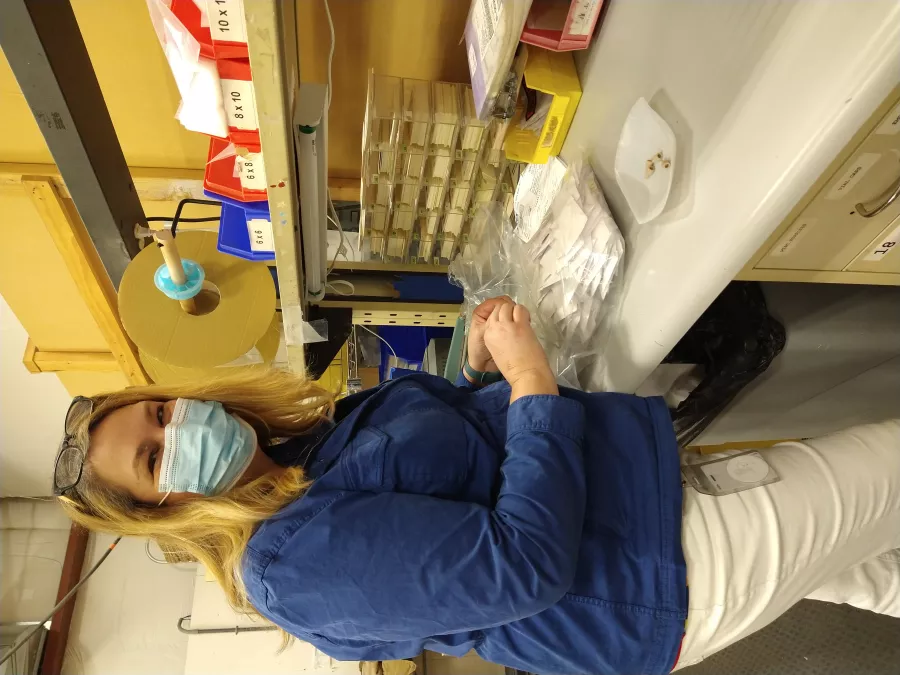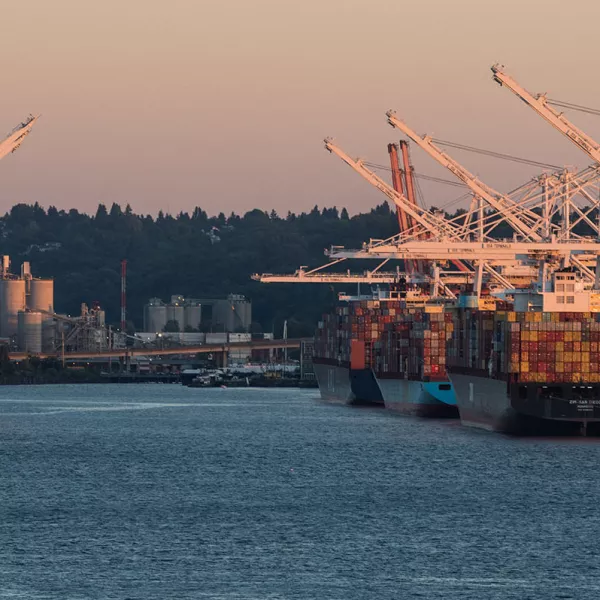Carlene Schmelke’s friends and family now have a much better understanding of what she does for a living.
Thanks to the economic disruption triggered by the global pandemic, anyone trying to buy a new car, re-tile their bathroom, or even get a schmear of cream cheese on their bagel can commiserate with Schmelke, the supply chain director for IDEX Health and Science. She’s responsible for making sure her colleagues can produce parts for the kind of specialized equipment that’s in high demand these days in medical and scientific laboratories.
“Supply chain is one of those things that if it’s running well, no one knows you exist,” says Schmelke, a member of the industry advisory board for Western’s Manufacturing and Supply Chain Management Program. “And that’s fine. We’re the backstage people.”
Now these backstage people are stepping out from behind the curtain to face the biggest challenges of their careers, simultaneously navigating bullwhipped demand swings, grinding disruptions in production and frustrating delays in shipping.
“It’s a measure of responsiveness, how quickly can your supply chain respond to a 20-percent increase or decrease in demand,” says Operations Management Professor Peter Haug, director of Western’s Manufacturing and Supply Chain Management program. But demand for some products like toilet paper, home office equipment, furniture and home renovation supplies increased by 50 percent or more at the beginning of the pandemic, Haug says, and no one was forecasting for that.
Managing risk
Like most supply chain executives, Schmelke spends a lot of her day trying to solve problems before they arise. Lately, she’s had to get more creative. Longtime suppliers are no longer able to keep up with the increased demand, so she’s establishing more secondary suppliers to keep production running. Worried about rising risks of hurricanes battering the Texas coastal factories that make polypropylene, for example, she’s socking away every bit of that thermoplastic polymer she can find, because it’s a key ingredient in plastics manufacturing. And when production is done, she faces shipping delays, and trying smaller, more frequent shipments to keep customers happy.
“Those buyers who are building relationships with suppliers when catastrophes aren’t happening are able to call in those favors,” she says. “I’ve been really, really proud of the supply chain professionals out there and the work they’re doing and the creativity they’re showing to get products to their customers as fast as they can.” But some problems, even creativity can’t solve.
Schmelke, who graduated in 1993 with a bachelor’s degree in production and operations management, has seen supply chain disruptions before— she also worked for Palm, a pre-cell phone personal device manufacturer, during the dot-com boom when electronic components were in short supply globally. She has also worked for Brunswick, a manufacturing company that makes Bayliner, SeaRay and Boston Whaler boats along with boat engines and parts.
But she’s never seen a labor shortage like this: Schmelke has been pulling her own shifts in the inventory warehouse, putting away supplies and parts as they arrive off the truck. “A whole bunch of people retired during COVID,” Schmelke says.
“Like us, our suppliers also do not have a big enough workforce to fill the gap.”
Meanwhile, their business supplying medical and scientific laboratories has already outpaced pre-pandemic sales. “We’re expecting to grow even more in 2022.”
Securing the commodities to build the parts is one thing, but shipping them to customers is a whole other challenge during COVID. It’s not uncommon for finished parts to be waiting for days to be loaded onto a truck in Kent or Everett for shipment to anxious customers, Schmelke says.
“Where in the supply chain is the problem? Where is the bottleneck?” Haug asks. “I think it’s probably a little bit of everything. Maybe they’re lacking stevedores to unload the ships. Maybe they don’t have enough crane operators or trucks to take the containers to the warehouse.”
The nearshore question
Weakness in any link of the chain creates a problem throughout the system and each link represents its own complex story. The trucking industry could use about 45,000 more truck drivers, says Haug, but who wants to start a career as a truck driver in a notoriously grueling industry that might be on the verge of automation?
When the pandemic first hit, demand for many products shrank and companies didn’t want to be stuck with unused inventory, so shipping ground to a halt, says supply chain consultant Jon Foil, ’00, B.S., manufacturing management. Then when demand came roaring back, there weren’t enough ships, containers or dock workers to move and unload them. International shipping companies, accustomed to operating on razor-thin margins, found they could charge two or three times their usual price to ship a container full of goods. Shipping companies are reluctant to give up that healthy margin, Foil says, and leery of investing in new shipping infrastructure. Who wants to build more ships, containers and trucks just to be stuck with them if demand drops in a few months’ time?
Foil, a member of the MSCM industry advisory board, previously worked for a manufacturing company that was poised to move its West Coast distribution center to the middle of the country to save on shipping costs and be closer to the bulk of customers.
But when it was going to cost two to three times more just to get the products from West Coast ports to the Midwest distribution center, the company scrapped the plans. Because of the increased costs in logistics, packaging and labor, companies will need to adjust their strategies to maintain their margins, Foil says. This may include options like increasing the order value to qualify for free shipping—or increasing prices.
Will the tumult in worldwide transportation encourage more U.S. companies to “nearshore” their factories closer to home? The idea is attractive to many companies, Foil says, but it won’t pencil out for everyone.
Athletic shoe manufacturing, for example, was particularly hard-hit by COVID-related shutdowns of factories in Vietnam. Moving operations to Latin America might be a good option, but there is a lack of established shoe manufacturing knowledge and infrastructure to support this shift, Foil says. As a result, companies might still be at the mercy of international shipping for their raw materials. They’d also have to train a new workforce to replace the knowledgeable workers they left behind.
“I think now more than ever there is a case to be made to nearshore,” Foil says. “I think countries will become more nationalistic and consumers won’t put up with supply chain issues. They’ll want more reliability. Will the majority of manufacturing come back to the U.S.? No, but I think there are more compelling reasons to nearshore now.”
Foil has worked at Brooks Running Co., Sur La Table, Starbucks and PMI, which makes high-end travel mugs and water bottles, and recently joined a startup called Planit Supply Chain Solutions, a software company that uses machine learning to help companies plan their inventories and manage risk more nimbly.
“There can no longer be any lag in data or information,” Foil says. “Things are changing too quickly.”
The software allows companies to run different types of scenarios to predict how they would navigate sharp changes in demand, for example. “Even smaller companies will need to do a supply chain risk assessment,” Foil says. Building a “rainy day” savings of three to six months of inventory is expensive, but so is the missed sales opportunity when stock runs out. The risk-reward trade-offs will only get more complicated.
“Companies really just can’t assume what happened in the past is going to happen in the future anymore,” Foil says. “Even if they look at the past year, there’s most likely not going to be a repeat of that next year, hopefully in a COVID-free environment. Many companies don’t have a reliable picture of what their future demand will look like.
“Take outdoor retailers. People were camping more and demand skyrocketed,” he continued. “But how sustainable is that? Is it the new normal? Are people going to do that more now so it will stay at that level, or did people get it out of their system so demand is going to drop off? Your guess is as good as mine.”
A circular solution
The broken places in the supply chain aren’t going away any time soon, but they also point to places due for lasting improvement, says Deborah Dull, ’07, B.A., operations management.
People are finally seeing how wasteful—and risky—global supply chains are, says Dull, an advocate of sustainable “circular” supply chains. Today’s “linear” supply chains are designed around “planned obsolescence”; shorter life spans force consumers to buy more items.
“We end up building waste into our systems because it saves us money,” she says. “What we haven’t done is create a supply chain structure that minimizes risk.”
Today, companies like Amazon and Costco are chartering their own ocean vessels to protect their supply chains from disruption in overseas shipping. “This is crazy-nuts,” Dull says. “It’s like a small town chartering Safeco Field for meetings because the town hall was flooded and they need another place to meet.”
Dull is the founder of the nonprofit Circular Supply Chain Network, and the senior director of research at Zero100, a new startup to promote zero-carbon, all-digital supply chains. Their target audience is the people who make up the global supply chain—estimated by Mercedes Delgado of the Copenhagen Business School at 44 million in the U.S. alone and about a third of the workforce. People who make decisions about inventory and shipping have the power to change the world, Dull says.
Circular supply chains eliminate the idea of waste by reusing regional materials, repairing items, and selling production by-products. “Circularity is about using our items for longer, reducing the need to buy more,” she says. Patagonia has made recent news
by promoting free repair workshops and selling used clothing on the same rack as new. The supply chain can help by finding different types of inputs—think reclaimed cottons and bio-materials—and adjusting production to support repair.
Meanwhile, a growing “right-to-repair” movement is gaining traction in Europe and the U.S., Dull says, with laws requiring manufacturers to make it easier for customers to repair their products. Dull predicts we’ll see more of those laws, along with “repair cafes” with tools for people to fix their own stuff.
Dull, who has worked in supply chain with GE Digital, Microsoft and the Bill & Melinda Gates Foundation, has been delivering keynote speeches about circularity at supply chain conferences for several years and is seeing the reception change. “At the beginning, it was ‘Wow, what a concept.’ Now, it’s, ‘What do we do to get started?’
“We truly do have the power to change the world,” she says.
More in Window magazine:
SHELF ENGINE: Harnessing data to fill grocery shelves
Stefan Kalb, ’07, is leading a business that optimizes supply chains of thousands of grocery stores across the country.
Manufacturing and Supply Chain Management at Western
New grads are in high demand.






